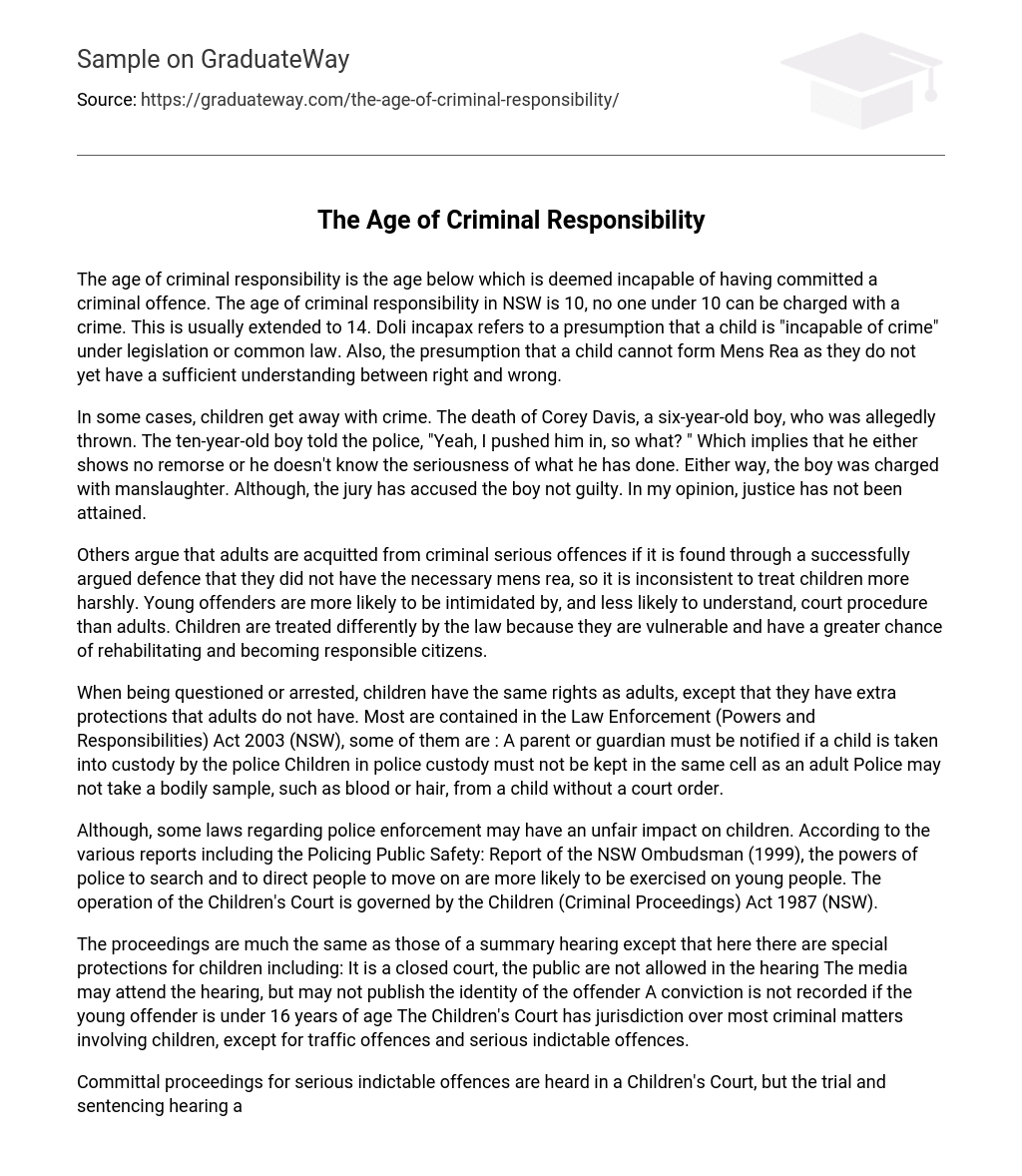The age of criminal responsibility is the age below which is deemed incapable of having committed a criminal offence. The age of criminal responsibility in NSW is 10, no one under 10 can be charged with a crime. This is usually extended to 14. Doli incapax refers to a presumption that a child is “incapable of crime” under legislation or common law. Also, the presumption that a child cannot form Mens Rea as they do not yet have a sufficient understanding between right and wrong.
In some cases, children get away with crime. The death of Corey Davis, a six-year-old boy, who was allegedly thrown. The ten-year-old boy told the police, “Yeah, I pushed him in, so what? ” Which implies that he either shows no remorse or he doesn’t know the seriousness of what he has done. Either way, the boy was charged with manslaughter. Although, the jury has accused the boy not guilty. In my opinion, justice has not been attained.
Others argue that adults are acquitted from criminal serious offences if it is found through a successfully argued defence that they did not have the necessary mens rea, so it is inconsistent to treat children more harshly. Young offenders are more likely to be intimidated by, and less likely to understand, court procedure than adults. Children are treated differently by the law because they are vulnerable and have a greater chance of rehabilitating and becoming responsible citizens.
When being questioned or arrested, children have the same rights as adults, except that they have extra protections that adults do not have. Most are contained in the Law Enforcement (Powers and Responsibilities) Act 2003 (NSW), some of them are : A parent or guardian must be notified if a child is taken into custody by the police Children in police custody must not be kept in the same cell as an adult Police may not take a bodily sample, such as blood or hair, from a child without a court order.
Although, some laws regarding police enforcement may have an unfair impact on children. According to the various reports including the Policing Public Safety: Report of the NSW Ombudsman (1999), the powers of police to search and to direct people to move on are more likely to be exercised on young people. The operation of the Children’s Court is governed by the Children (Criminal Proceedings) Act 1987 (NSW).
The proceedings are much the same as those of a summary hearing except that here there are special protections for children including: It is a closed court, the public are not allowed in the hearing The media may attend the hearing, but may not publish the identity of the offender A conviction is not recorded if the young offender is under 16 years of age The Children’s Court has jurisdiction over most criminal matters involving children, except for traffic offences and serious indictable offences.
Committal proceedings for serious indictable offences are heard in a Children’s Court, but the trial and sentencing hearing are heard in either the District Court or the Supreme Court. When a child has pleaded guilty or has been found guilty of a criminal offence, the Children’s court must follow principles of sentencing set out in the the Children (Criminal Proceedings) Act 1987 (NSW). Most penalties and sentencing options available to the court are similar to those available for adult offenders. Dismissal of the charges, or dismissal with caution
Imposing a fine Probation A community service order Suspended sentence Imprisonment : For juveniles, sending the child to be detained in a juvenile detention centre. For young offenders, there are several alternatives to court, the main alternatives being those provided under the Young Offenders Act 1997 (NSW). The police must consider giving the youth offender a warning, or a caution, or instructing them to attend a conference. Court proceedings can only be commenced if these options are clearly inappropriate.
The Youth Offenders Act 1997 (NSW) introduced youth justice conferencing. Present at the conference are: the young offender; a parent, guardian, or any other close associate of the offender; the victim; a supporter for the victim; and a mediator. The aim of these conferences is to come up with an agreement which may include an apology for the victim, reparation made to the victim, drug or alcohol rehabilitation for the young offender, or anything else considered appropriate.





